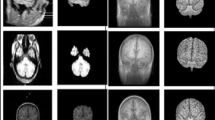Abstract
Magnetic Resonance Imaging (MRI) is a popular tool for detection of diseases, as it can provide details about physiological and the chemical components of the tissues, for which the investigation needs to be carried out. The advantage of MRI over other medical imaging techniques is that sectional image of same resolution can be produced without moving the patients. However, the pixel intensity of the grey matter and non-grey matter, which are present in the brain, is almost similar. Hence it creates difficulty in identification and diagnosis of brain diseases. Therefore, identifying and removing the non-brain tissue like skull is very vital for accurate diagnosis of brain-related diseases. This removal of skeletal structure from a brain MRI is called skull stripping. In this paper, different brain MRI skull stripping techniques are discussed and performance analysis is presented with respect to their ground truth images.
Access this chapter
Tax calculation will be finalised at checkout
Purchases are for personal use only
Similar content being viewed by others
References
V.B.R. Palavi, L. Patil, MR images techniques. Int. J. Adv. Res. Comput. Commun. Eng. 4(2), 304–308 (2015)
V.B.P.P Kalavathi, Methods on skull stripping of mri head scan images—a review (2016)
P. Bao, L. Zhang, Noise reduction for magnetic resonance images via adaptive multiscale products thresholding. IEEE Trans. Med. Imaging 22(9), 1089–1099 (2003)
N. Kumar, M. Nachamai, Noise removal and filtering techniques used in medical images. Orient. J. Comput. Sci. Technol. 103–113 (2017)
J. Harikiran, B. Saichandana, B. Divakar, Impulse noise removal in digital images. Int. J. Comput. Appl. (0975–8887) Volume, (2010)
S. Vaishali, K.K. Rao, G.S. Rao, A review on noise reduction methods for brain mri images, 363–365 (2015)
M. Sonawane, C. Dhawale, A briefsurvey on image segmentation methods, in IJCA Proceedings on National Conference on Digital Image and Signal Processing (Citeseer, 2015)
S. Kamdi, R. Krishna, Imagesegmentation and region growing algorithm. Int. J. Comput. Technol. Electron. Eng. (IJCTEE) 2 (2012)
D. Krstinic, A.K. Skelin, I. Slapnicar, Fast two-step histogram-based image segmentation. IET Image Proc. 5(1), 63–72 (2011)
P.D.R. Raju, G. Neelima, Image segmentation by using histogram thresholding. Int. J. Comput. Sci. Eng. Technol. 2(1), 776–779 (2012)
K. Sharma, A. Kaur, S. Gujral, A review on various brain tumor detection techniques in brain mri images. IOSR J. Eng. 4(5), 6–12 (2014)
H.-Y. Li, W.-J. Hwang, C.-Y. Chang, Efficient fuzzy c-means architecture for image segmentation. Sensors 11(7), 6697–6718 (2011)
P. Srivastava, N. Sharma, Fuzzy risk assessment information system for coronary heart disease, in International Conference on Innovative Computing and Communications (Springer, Singapore, 2019), pp. 159–170
M. Yambal, H. Gupta, Image segmentation using fuzzy c meansclustering: a survey. Int. J. Adv. Res. Comput. Commun. Eng. 2(7) (2013)
K.K. Bhoyar et al., Color image segmentation usingfast fuzzy c-means algorithm. ELCVIA Electron. Lett. Comput. Vis. Image Anal. 9(1), 18–31 (2010)
Y. Yang, S. Huang, Image segmentation by fuzzyc-means clustering algorithm with a novel penalty term. Comput. Inform. 26(1), 17–31 (2012)
P. Panwar, R.K. Girdhar Gopal, Image segmentation using k-means clustering and thresholding. IRJET 3(5), 1787–1793 (2016)
V.S. Piyush, M. Patel, B.N. Shah, Image segmentation using k-meanclustering for finding tumor in medical application. IJCTT 4(5), 1787–1793 (2016)
A.M. Almajidi, V.P. Pawar A. Alammari, K-means-based method for clustering and validating wireless sensor network, in International Conference on Innovative Computing and Communications (Springer, Singapore, 2019), pp. 251–258
S.A. Burney, H. Tariq, K-means clusteranalysis for image segmentation. Int. J. Comput. Appl. 96(4) (2014)
A.K.S. Anju Bala, Split and merge: Aregion based image segmentation. IJERMT 6(8), 306–309 (2017)
N. Tools, R. Collaboratory, Mircen macaca fascicularis brain mri segmentation dataset. https://www.nitrc.org/projects/mircen_macset (2017)
Author information
Authors and Affiliations
Corresponding author
Editor information
Editors and Affiliations
Rights and permissions
Copyright information
© 2020 Springer Nature Singapore Pte Ltd.
About this paper
Cite this paper
Hazarika, R.A., Kharkongor, K., Sanyal, S., Maji, A.K. (2020). A Comparative Study on Different Skull Stripping Techniques from Brain Magnetic Resonance Imaging. In: Khanna, A., Gupta, D., Bhattacharyya, S., Snasel, V., Platos, J., Hassanien, A. (eds) International Conference on Innovative Computing and Communications. Advances in Intelligent Systems and Computing, vol 1087. Springer, Singapore. https://doi.org/10.1007/978-981-15-1286-5_24
Download citation
DOI: https://doi.org/10.1007/978-981-15-1286-5_24
Published:
Publisher Name: Springer, Singapore
Print ISBN: 978-981-15-1285-8
Online ISBN: 978-981-15-1286-5
eBook Packages: Intelligent Technologies and RoboticsIntelligent Technologies and Robotics (R0)




